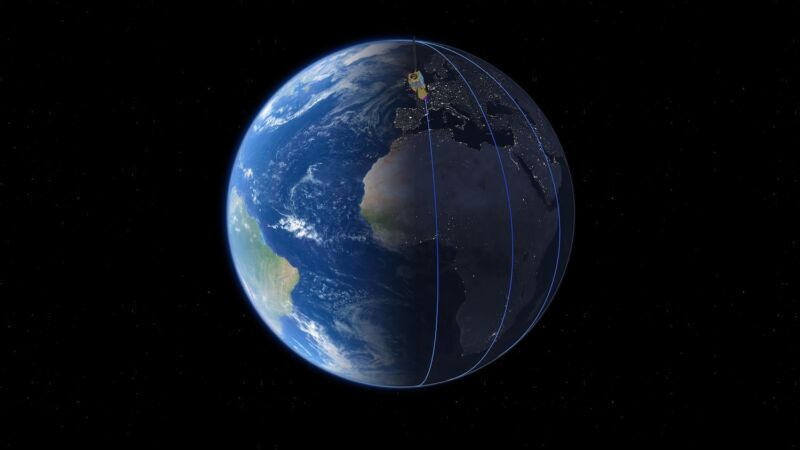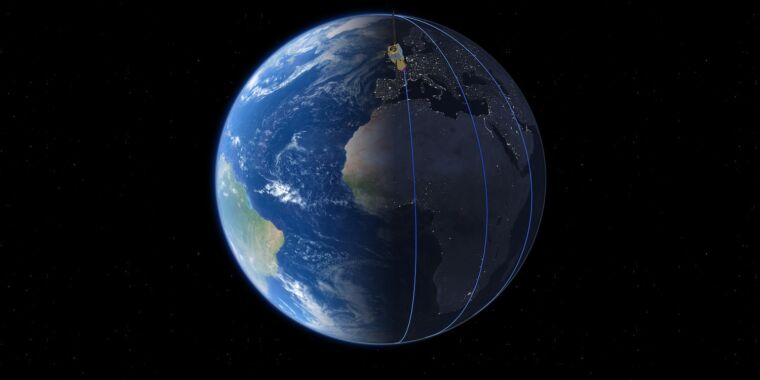
The European Space Agency deftly guided one of its satellites toward a fiery re-entry into Earth’s atmosphere Friday, demonstrating a new method of post-mission disposal to ensure the spacecraft would not fall into any populated areas.
The Aeolus satellite was relatively modest in size and mass—about 1.1 metric tons with its fuel tank empty—but ESA hailed Friday’s “assisted re-entry” as proof that the space agency takes the stewardship of space seriously.
When the Aeolus mission was conceived in the late 1990s, there were no guidelines for European satellites regarding space debris or the safety of their re-entry. Aeolus took nearly 20 years to get to the launch pad, operated in space for five years, and now regulations have changed. Future ESA satellites will need to be capable of a targeted re-entry, where rocket engines steer the spacecraft toward a specific patch of ocean or are designed to burn up from aerodynamic heating.
Because it was designed two decades ago, Aeolus did not have to meet these standards, and the satellite didn’t have a propulsion system that could target a pinpoint re-entry. Engineers originally anticipated Aeolus would naturally re-enter the atmosphere after running of fuel. Because it was in a polar orbit, Aeolus could have fallen nearly anywhere. ESA expected about 20 percent of the spacecraft would survive the scorching temperatures of re-entry and make it to Earth’s surface.
Officials decided to end Aeolus’s science mission measuring winds from space in April when the satellite still had some gas in the tank—enough for a series of thruster firings to steer the satellite toward a re-entry corridor well away from any people.
“This is quite unique, what we are doing here,” said Holger Krag, head of ESA’s safety office, before Friday’s final re-entry maneuvers. “You don’t find examples of this in the history of spaceflight. The re-entry of the Skylab space station in the late ‘70s—that was a bit of a similar type of assisted re-entry by changing the attitude and therefore changing the exposed area (to atmospheric drag).”
NASA put Skylab into a tumble in an attempt to better control where the spacecraft fell to Earth, but debris from the 76-metric ton space station was scattered across Western Australia when it re-entered the atmosphere in 1979. NASA’s efforts in 1979 had a “far lower level of control than we have here today,” Krag said.
“We are doing this with the best standards that we have today,” said Simonetta Cheli, ESA’s director for Earth observation.
Krag said he hopes ESA becomes a “role model” for other space agencies and commercial companies to commit to tackling the problem of space debris and the dangers of uncontrolled re-entry. ESA is partnering with a Swiss company for a mission in 2026 to demonstrate the removal of a piece of space junk from orbit.
Heavy lifting
During its nearly five-year mission, Aeolus flew in a polar orbit at an altitude of about 200 miles (320 kilometers), already lower than the height of the International Space Station and most other satellites. Aeolus was a pioneering Earth science mission that measured wind speeds around the world using a sophisticated on-board laser, and it was so successful that ESA and the European weather satellite agency Eumetsat plan to launch a follow-on mission called Aeolus 2 planned for launch at the end of the decade.
Aeolus was originally designed as a science and technology demonstration mission, but its global wind measurements proved so valuable that the data were incorporated into operational numerical weather forecast models, an eventuality not foreseen before the satellite’s launch. The mission was delayed for years until it finally launched on a European Vega rocket in 2018, and challenges with developing the satellite’s space-based laser instrument earned it the nickname the “impossible mission.”
ESA called it quits on the more than $500 million mission in April, then prepared to bring down the satellite. Aeolus first descended to an altitude of about 174 miles (280 kilometers) with nothing but the effect of aerodynamic drag. Then a sequence of thruster burns began lowering the orbit until a final maneuver Friday brought the altitude of the orbit’s perigee, or lowest point, to just 75 miles (120 kilometers).
Nature took care of the rest. The gentle push of drag from the uppermost wisps of Earth’s atmosphere would have pulled Aeolus closer to Earth until it broke apart around 50 miles (80 kilometers) above the surface. ESA’s ground team in Germany put the satellite on a trajectory where it was expected to burn up over the Atlantic Ocean.
“Operations are over for Aeolus,” tweeted Josef Aschbacher, ESA’s director general. “Latest tracking data confirms our final maneuver was successful, and the hard work and dedication of the teams has given Aeolus a great chance for safe re-entry tonight.”

